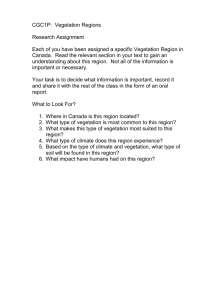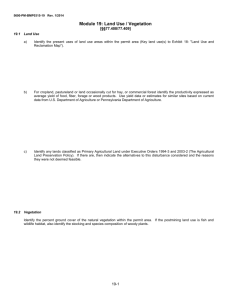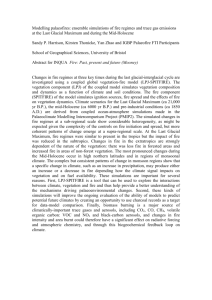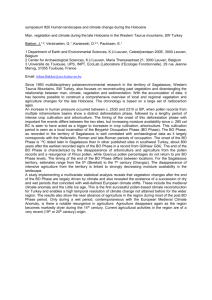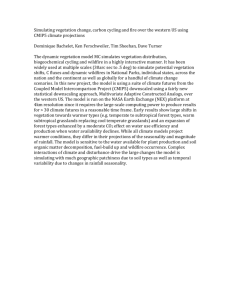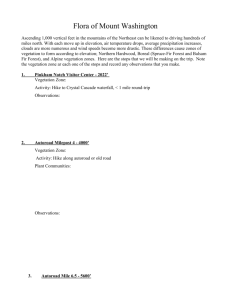9 Holocene rapid land-cover changes - Max-Planck
advertisement
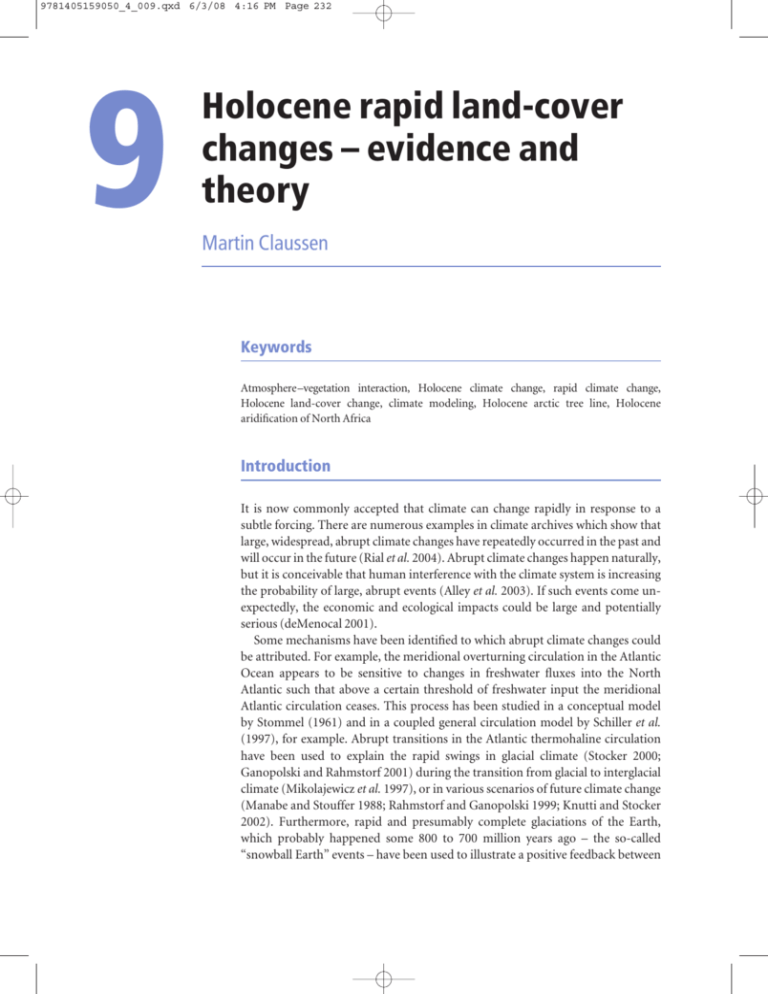
9781405159050_4_009.qxd 6/3/08 4:16 PM Page 232 9 Holocene rapid land-cover changes – evidence and theory Martin Claussen Keywords Atmosphere–vegetation interaction, Holocene climate change, rapid climate change, Holocene land-cover change, climate modeling, Holocene arctic tree line, Holocene aridification of North Africa Introduction It is now commonly accepted that climate can change rapidly in response to a subtle forcing. There are numerous examples in climate archives which show that large, widespread, abrupt climate changes have repeatedly occurred in the past and will occur in the future (Rial et al. 2004). Abrupt climate changes happen naturally, but it is conceivable that human interference with the climate system is increasing the probability of large, abrupt events (Alley et al. 2003). If such events come unexpectedly, the economic and ecological impacts could be large and potentially serious (deMenocal 2001). Some mechanisms have been identified to which abrupt climate changes could be attributed. For example, the meridional overturning circulation in the Atlantic Ocean appears to be sensitive to changes in freshwater fluxes into the North Atlantic such that above a certain threshold of freshwater input the meridional Atlantic circulation ceases. This process has been studied in a conceptual model by Stommel (1961) and in a coupled general circulation model by Schiller et al. (1997), for example. Abrupt transitions in the Atlantic thermohaline circulation have been used to explain the rapid swings in glacial climate (Stocker 2000; Ganopolski and Rahmstorf 2001) during the transition from glacial to interglacial climate (Mikolajewicz et al. 1997), or in various scenarios of future climate change (Manabe and Stouffer 1988; Rahmstorf and Ganopolski 1999; Knutti and Stocker 2002). Furthermore, rapid and presumably complete glaciations of the Earth, which probably happened some 800 to 700 million years ago – the so-called “snowball Earth” events – have been used to illustrate a positive feedback between .. .. 9781405159050_4_009.qxd 6/3/08 4:16 PM Page 233 Holocene rapid land-cover changes | 233 the high albedo of ice caps and the atmospheric energy balance (see Hoffman and Schrag 2002). Likewise, a rapid onset of the last glacial was simulated by Calov et al. (2005), again, based on earlier theories of the atmosphere–cryosphere feedback by Budyko (1969) and Sellers (1969). Ecosystems, when exposed to gradual changes in climate, nutrient loading, or habitat fragmentation, for example, may exhibit drastic switches to a new state. Examples include the dynamics of freshwater and marine ecosystems, forests, and arid lands (Scheffer et al. 2001). Jennerjahn et al. (2004) found that rapid shifts of tropical ecosystems occurred during the last ice age, and Hughen et al. (2004) showed the same for ecosystems in South America during the last deglaciation. In the Holocene, the western Sahara is hypothesized to have expanded rapidly some 5500 years BP (deMenocal et al. 2000), and the apparent forcing, the global distribution of insolation, has changed steadily for the past several thousand years (see Figure 9.1). Petit-Maire and Guo (1996) reported large climatic fluctuations in the Sahara, with wet periods occurring during the early Holocene and around 5000 years BP, and two more arid episodes occurring at 6700–5500 years BP and at 4000–3600 years BP. The latter episode was severe, ruining ancient civilizations and socio-economic systems. In addition Cremaschi et al. (2006) described major drought spells at 5900–5760 years BP and at 5120 years BP in the central Sahara, followed by phases of enhanced precipitation and by the onset of extreme arid conditions at 1500 years BP. At high northern latitudes, tree macrofossils apparently vanished between 4000 and 3000 years BP (MacDonald et al. 2000; Figure 9.1, bottom). Most of these periods characterized by rapid land-cover change correspond to one of the six periods of Holocene rapid climate change identified by Mayewski et al. (2004). In this paper, large-scale Holocene land-cover change and associated biogeophysical feedbacks are addressed. Special emphasis is given to the underlying theory of rapid land-cover change in order to explore the possibility of predicting other so-called hot spots, i.e., regions on Earth that react very sensitively to changes in external forcing, in particular to anthropogenic land-cover change or emissions of greenhouse gases related to fossil-fuel use. Rapid land-cover change in North Africa Paleobotanic and paleoclimatic evidence indicates that during the early and mid-Holocene, some 11 500 to 6000 years BP, the Sahara was much greener than today (Prentice et al. 2000), and the Sahel reached at least as far north as 23°N in some parts of North Africa (Jolly et al. 1998). The greening was attributed to an increase in the North African summer monsoon as a response to changing orbital forcing (Kutzbach and Guetter 1986). The increase in summer monsoon triggered by changes in the Earth’s orbit around the Sun and in the tilt of the Earth’s axis, however, did not seem to be large enough to explain a large-scale greening (Joussaume et al. 1999). Claussen and Gayler (1997) found a strong feedback .. .. 9781405159050_4_009.qxd 6/3/08 4:16 PM Page 234 Terrigenous sediment (%) Figure 9.1 (top) Changes in Northern Hemisphere insolation over the past 9000 years from Berger (1978), (middle) changes in terrigenous sediment off the coast of North Africa (deMenocal et al. 2000) indicating an abrupt expansion of the western part of the Sahara around 5500 years ago, and (bottom) changes in the number of Russian tree macrofossils recorded (MacDonald et al. 2000) indicating a southward retreat of Arctic trees between 5000 and 3000 years ago. Please note that the latter is presented in uncalibrated radiocarbon years before present, so that the time axis of the upper and middle figure might not match, if the latter data were calibrated. Summer insolation (W m–2) | Martin Claussen Russian tree macrofossils number of samples 234 470 Radiation forcing 460 450 440 40 Aeolian dust record at ocean site 658C 50 60 60 50 40 30 20 10 0 9000 8000 7000 6000 4000 5000 Age (yr BP) 3000 2000 1000 0 between vegetation and precipitation, mainly in the western part of the Sahara, which could amplify the increase in summer monsoon to foster a northward shift of Sahelian vegetation. Claussen and Gayler explained the positive feedback by an interaction between high albedo of Saharan sand deserts and tropical atmospheric circulation, as assumed by Otterman (1974) and described in a model by Charney (1975). Charney (1975) hypothesized that the high albedo over sub-tropical deserts causes a radiative cooling because the sum of incoming solar radiation, reflected solar radiation, and outgoing long-wave radiation is negative at the top of the atmosphere: more radiation leaves than enters the atmosphere above a sub-tropical desert. The local radiative cooling induces a subsidence of air masses, which compensates the cooling by adiabatic heating. The sinking motion suppresses convective precipitation. The reduction of precipitation is supposed to cause further vegetation degradation, thus enhancing the growth of desertlike conditions. Interestingly, Otterman (1974) and Charney (1975) focused not on the Sahara, but on the question of whether ongoing Sahelian drought could be caused by an increase in albedo due to overgrazing. Later on, however, it was found that changes in Sahelian albedo are too small to explain a strong desertalbedo effect (Xue and Shukla 1993), and that presumably mechanisms other than Charney’s biogeophysical feedback dominate (see, e.g. Eltahir and Gong 1995).) .. .. 9781405159050_4_009.qxd 6/3/08 4:16 PM Page 235 Holocene rapid land-cover changes | 235 State (a) Conditions State (b) Conditions State (c) Conditions Figure 9.2 Possible changes of ecosystem equilibrium states as a function of variations in conditions, such as climate or nutrient loading. In case (a), the system changes gradually with external conditions. Any perturbation away from the equilibrium state will decay – as indicated by the arrows – towards the equilibrium line (solid line). Case (b) shows a system which is rather inert over certain ranges of conditions while responding more strongly when conditions exceed a critical level (shaded area). A particularly interesting case (c) arises when a system exhibits multiple equilibria for certain environmental conditions. In such a case abrupt shifts from one state to the other state are possible if conditions exceed, perhaps randomly, some threshold near points B1 or B2. In the presence of strong perturbations (indicated by the thick arrow) the system might jump from the upper stable equilibrium to the lower stable one. The dashed line depicts an unstable equilibrium. Any infinitesimally small perturbation would drive the system away from the unstable equilibrium towards a stable one. (This figure is taken with modifications from Scheffer et al. 2001.) To study Holocene land-cover changes in the Sahara, Brovkin et al. (1998; and later on, others, cited below) analyzed the stability of the atmosphere–vegetation system in West Africa. The basic concept of such a stability analysis is outlined by Scheffer et al. (2001). They showed that, generally speaking, a system can reveal different stability characteristics. The system could change gradually, or even linearly, when external conditions change (see Figure 9.2a). In other cases, a system may be rather inert over certain ranges of conditions while responding more strongly, however, when conditions approach a critical level (Figure 9.2b). A particularly interesting case arises when a system exhibits alternative states, or multiple equilibria, for certain environmental conditions. In such a case, abrupt shifts from one state to the other state are possible if ubiquitous perturbations, either internally generated or externally imposed, exceed some threshold (Figure 9.2c). Regions in which the atmosphere–biosphere system, or more generally the climate system including atmosphere, biosphere, hydrosphere, pedosphere, and cryosphere, behaves like cases (b) and (c) are tentatively defined as “hot spots” in this paper. How does this conceptual model apply to the dynamics of Saharan greening? Theoretical studies by Claussen (1994, 1997) revealed that the biogeophysical feedback in the western part of North Africa leads to multiple equilibrium solutions for present-day climate (see Figure 9.3a). For mid-Holocene climate, only one equilibrium solution for West African climate was found (Claussen and Gayler .. .. 9781405159050_4_009.qxd 6/3/08 4:16 PM Page 236 236 | Martin Claussen (a) Figure 9.3 The equilibrium solutions obtained in the ECHAM-3–BIOME 1.0 model for (a) present-day climate according to Claussen (1997), (b) mid-Holocene climate (6000 years BP) after Claussen and Gayler (1997) and (c) for the climate of the Last Glacial Maximum some 21 000 years ago according to Kubatzki and Claussen (1998). The vegetation fraction is translated into land surface albedo. An albedo value above 0.25 corresponds to desert conditions. The left column shows the desert equilibrium, and the right column, the “green” equilibrium. Note that for the mid-Holocene situation (b), only a “green” solution was found. (This figure is taken with modifications from Brovkin et al. (1998). Copyright 1998 by the American Geophysical Union.) 40°N 40°N 20°N 20°N EQ EQ 20°W 0°E 20°E 40°E (b) 20°W 0°E 20°E 40°E 20°W 0°E 20°E 40°E 20°W 0°E 20°E 40°E 40°N 20°N EQ (c) 40°N 40°N 20°N 20°N EQ EQ 20°W 0°E 20°E 40°E 0.15 0.2 0.25 Land surface albedo 1997) (Figure 9.3b). For glacial climate, however, the possibility of two solutions appears again (Kubatzki and Claussen 1998) (Figure 9.3b). Obviously, the atmosphere–biosphere system changes its stability depending on orbital forcing. While in present-day climate and in glacial climate the global insolation patterns are similar, Northern Hemisphere regions received up to 10 percent more insolation some 6000 years BP during boreal summer, and up to 15 percent less insolation during boreal winter (Berger 1978). Brovkin et al. (1998) hypothesized, therefore, that bifurcations and associated abrupt climate and vegetation changes could occur during the transition from middle Holocene to present-day climate and from the late glacial to early Holocene climate. To investigate this process and to explore the consequences of this hypothesis in detail, Brovkin et al. (1998) set up a mathematical version of the conceptual model, a minimal model of sub-tropical atmosphere–vegetation interaction. .. .. 9781405159050_4_009.qxd 6/3/08 4:16 PM Page 237 Holocene rapid land-cover changes | 237 Figure 9.4 Stability diagram of a conceptual model of subtropical vegetation–precipitation feedback. The solid line indicates the changes in vegetation cover V* as a function of precipitation P (Equation 1 in the text). The dashed lines represent the expected precipitation P*(V,E) for given vegetation cover without feedback between biosphere and atmosphere (Equation 2 in the text). The various dashed lines differ in assumed external forcing E, e.g. changes in insolation. The intersections of both curves are the equilibrium solution of the coupled system. Solutions Id, IId, IIg, and IIIg are stable equilibria, and II* is an unstable equilibrium. (This figure is taken from Brovkin et al. (1998). Copyright 1998 by the American Geophysical Union.) The minimal model of Brovkin et al. is depicted in Figure 9.4. The solid line represents the dependence of equilibrium vegetation cover V*(P) on annual mean precipitation P, assumed to be given by ⎧ 0 V*(P) = ⎪⎨ 1 ⎪1 − 1 + a(P − Pcr )2 ⎩ if P < Pcr otherwise (1) where a and Pcr are parameters obtained by processing ecosystem data of Olson et al. (1985) and precipitation data of Leemans and Cramer (1991) following the approach of continuous vegetation description by Brovkin et al. (1997). V* is assumed to depend only on precipitation P, but not on external conditions E, such as insolation or atmospheric CO2 concentration, for example. Hence it is assumed that V*(P) is nearly constant over time. The dashed lines in Figure 9.4 represent a linear model of expected precipitation P*(V,E) for given vegetation V and external conditions E. No feedback between vegetation and precipitation is assumed, and P*(V,E) is approximated by P*(V,E) = Pd(E) + b(E)V (2) where Pd(E) and b(E) are parameters to be adjusted to data or to results of comprehensive models in which precipitation is computed under prescribed, constant vegetation cover for the region in question, i.e., West Africa in this case. The intersections of the curves V*(P) and P*(V,E) represent the equilibrium solutions of the system when vegetation dynamics and atmospheric dynamics are allowed to interact. In Figure 9.4, three possible examples are shown: two examples of a system exhibiting only one equilibrium solution, a desert solution Id and a green solution IIIg. The latter case corresponds to the situation in the mid-Holocene according to the simulations shown in Figure 9.3. The present-day and glacial situation is characterized by a system revealing three solutions (IId, II*, IIg). It can be shown that .. .. 9781405159050_4_009.qxd 6/3/08 4:16 PM Page 238 238 | Martin Claussen the solution II* is unstable to infinitesimally small perturbations. Further analysis of the model results depicted in Figure 9.3 shows that for present-day conditions IId is more stable than IIg, i.e., the system is expected to reside more often near IId than near IIg in the presence of finite-amplitude perturbations in rainfall. This could explain the existence of the Sahara today to be more likely than a strongly reduced, or greener, Sahara. The transient vegetation/climate change in West Africa can be interpreted in terms of changes in the parameter E, which determines slope and origin of P*(V,E). As the Earth’s orbit around the Sun varies, the strength of the African summer monsoon changes, which takes the atmosphere–vegetation system from a unistable situation (represented by case III with a green equilibrium solution IIIg in Figure 9.4) to a bistable situation (represented by case II with two stable solutions IId and IIg). When the bistable situation is reached, then it depends on the stability of the green solution IIg and the strength of perturbation, such as variations in precipitation or vegetation cover, whether a jump from the green to the desert state occurs. Using a box climate model of sub-tropical monsoon dynamics, Brovkin et al. (1998) predicted that before 6000 years BP the atmosphere–vegetation system in North Africa revealed a stability as indicated by case III in Figure 9.4 with only one, green solution IIIg. Because of the change in insolation, the dashed line P*(V,E) shifts to the left until around 6000 years BP and a situation is reached that is sketched as case II in Figure 9.4, with a desert solution IId in addition to a green solution IIg. Around 3600 years BP, the desert solution IId and the green solution IIg appeared to exhibit the same stability, i.e., the likelihood that the system resides near IId or near IIg is the same. As the variability in precipitation, which triggers switches between equilibrium states, appears to be larger the greener the region, Brovkin et al. (1998) concluded that the jump from the green to the desert state should have happened between 6000 and 3600 years BP. It is also conceivable that a jump between states does not occur once, but that for some period of time the system jumps back and forth between the desert and the green state. By using the Earth System Model of Intermediate Complexity, CLIMBER-2, Claussen et al. (1999) predicted a fast expansion of the Sahara some 5500 years BP (see Figure 9.5), which agrees well with the reconstruction of an abrupt change in terrestrial dust transport from western Africa into the North Atlantic (deMenocal et al. 2000; see Figure 9.1). Sensitivity tests (not shown here) revealed that CLIMBER-2 does not exhibit distinct green and desert-like equilibrium solutions for the same values of insolation as the more comprehensive atmosphere–biome model used by Claussen (1997), Claussen and Gayler (1997), and Kubatzki and Claussen (1998) (see Figure 9.3) does. Hence Claussen et al. (1999) concluded that the fast transition seen in CLIMBER-2 was not a bifurcation of the atmosphere– vegetation system, but a fast transition corresponding to case (b) in Figure 9.2. The authors attribute this effect to the coarse spatial resolution of CLIMBER-2, which does not differentiate between the western and eastern Sahara. Paleobotanic and paleoclimatic evidence suggests that Holocene climate trends in the western and eastern Sahara differ. The abrupt increase in terrestrial dust flux .. .. 9781405159050_4_009.qxd 6/3/08 4:16 PM Page 239 Holocene rapid land-cover changes Figure 9.5 Simulated decrease in relative vegetation coverage f as a function of time. Different curves refer to simulations with different initial conditions, but the same climate forcing. In this figure, only 2000 years of the simulations, which span the past 9000 years, are depicted. (This figure is taken from Claussen et al. (1999). Copyright 1999 by the American Geophysical Union.) .. .. | 239 0.8 0.6 f 0.4 0.2 0.0 –6000 –5800 –5600 –5400 –5200 –5000 –4800 –4600 –4400 –4200 –4000 Year from the western part of Sahara as recorded in marine sediments off the coast of North Africa near Cape Blanc, Mauretania, by deMenocal et al. (2000) (see Figure 9.1) suggests a single abrupt aridification around 5500 years BP. Pachur (1999) found that the aridification in the eastern part of the Sahara increased more gradually with a period of larger variability between 7000 and 4500 years BP (Pachur 1999). Rapid swings between the arid and the wet state were also found in reconstructions from several hundred 14C dates around the Tropic of Cancer by Petit-Maire and Guo (1996) and from tree rings in the central Sahara by Crematschi et al. (2006). Strong variations in Saharan vegetation between 7000 and 5000 years BP were found (see Figure 9.6) by Renssen et al. (2003) in their model, ECBILT– CLIO–VECODE, a coupled atmosphere–ocean–vegetation model of intermediate complexity. In contrast to the CLIMBER-2, the model by Renssen et al. has a much stronger variability in rainfall. Renssen et al. (2003)showed that the change in variability in their model could be attributed to a bistability of the system during the period of strong variations. For that purpose they constructed a stability diagram, as in Figure 9.4, following Brovkin et al. (1998). They performed several experiments with prescribed vegetation cover to obtain a linear curve P*(V,tn) where tn stands for time slices 9000 years BP, 6000 years BP, and 0 years BP. The curve V*(P) was taken from the vegetation model with prescribed precipitation changes. For today, the stability diagram indicated a desert solution only, as case I in Figure 9.4. For 9000 years BP and 6000 years BP, two stable solutions appeared, as case II in Figure 9.4. Further experiments showed that for 9000 years BP the desert solution (represented as IId in Figure 9.4) was not stable in the presence of simulated climate variations. The possibility of multiple solutions and rapid swings between the desert and green state in the model is qualitatively consistent with reconstructions by Petit-Maire and Guo (1996), Pachur (1999), and Cremaschi et al. (2006). Zeng and Neelin (2000), Wang (2004), and Liu et al. (2006) explored the role of rainfall variability on the transition between green and desert-like conditions in North Africa. They found that strong rainfall variability could prevent the system from staying in one equilibrium. Instead, one would detect a strong variability in vegetation cover which, on average over decades and centuries, would decline 9781405159050_4_009.qxd 6/3/08 4:16 PM Page 240 240 | Martin Claussen Vegetation cover in western Sahara 90 80 70 60 Percent Figure 9.6 Simulated decrease in percentage of vegetation cover in the western Sahara/Sahel region (14°W to 3°E, 17°N to 28°N) as a function of time. (This figure is taken from Renssen et al. (2003). Copyright 2003 by the American Geophysical Union.) 50 40 30 20 10 0 9 8 7 6 5 4 Time (kyr BP) 3 2 1 0 smoothly. Only if variability occurs at sufficiently long time-scales (say, at decades instead of years), then abrupt transitions occur (this case is referred to as an “unstable collapse” in Liu et al. 2006). From their studies, one can conclude that bistability is neither a necessary nor sufficient condition for multiple transitions between green and desert-like conditions. These can occur in the presence of only one equilibrium solution, provided that the slope of curve V*(P) is sufficiently close to that of (P*(V,E))−1 and that there is slow (i.e., decadal or longer) rainfall variability (or “stable collapse” according to Liu et al. 2006). Not all models reveal abrupt changes during the Holocene in northern Africa. The model by Wang et al. (2005) seems to follow insolation rather linearly, although the same vegetation model was used as implemented in CLIMBER-2 and the model by Renssen et al. (2003). Perhaps the atmospheric model, a sectorially averaged energy balance model, used by Wang et al. (2005) is not capable of properly simulating deviations from the zonal mean. The idea of multiple equilibria in West Africa and vegetation/climate changes caused by bifurcations of the system was pursued further by Wang and Eltahir (2000), who used a zonally averaged atmospheric model for West Africa synchronously coupled to a dynamic vegetation model. They explained the decadal variability in the 20th century in terms of bifurcations of the West African atmosphere–vegetation system. Using Wang’s and Eltahir’s model, Irizarry-Oritz et al. (2003) obtained bistability of the atmosphere–vegetation system for West Africa for the mid-Holocene period, thereby corroborating the results by Renssen et al. (2003). Also Zeng and Neelin (2000), by using an atmospheric model of the tropics coupled to a dynamic vegetation model, explored the effect of multi-stability in the West African region. Hence multiple equilibrium solutions in West Africa are seen in atmosphere–vegetation models of different complexity and different structure. This suggests that the notion of multi-stability in the atmosphere–biosphere system and associated rapid land-cover changes in that region seems to be robust, although the details of the transition from a green Sahara to today’s desert are not fully understood. .. .. 9781405159050_4_009.qxd 6/3/08 4:16 PM Page 241 Holocene rapid land-cover changes | 241 In the context of rapid land-cover changes in West Africa, the question arises whether early human land-use could have led to fast land-cover changes (e.g. Ruddiman (2003) in the context of mid-Holocene increase in atmospheric CO2 concentration). Kubatzki (2000) tested this hypothesis by repeating the simulations of Claussen et al. (1999) and by perturbing vegetation cover in the simulations. Kubatzki (2000) reduced the vegetation of the green Sahara in the early to mid-Holocene periodically to a fractional coverage of 0.2. The resulting simulation revealed only small differences between perturbed and unperturbed cases, which suggests that early human land-cover change affected West African desert dynamics only marginally. Rapid land-cover change in other regions of the world After having discussed rapid land-cover change in North Africa, the question arises as to whether there is evidence of rapid land-cover changes in other regions of the world. After Fennoscandian and Laurentian ice sheets of the last Ice Age had disappeared, boreal forests colonized high northern latitudes and eventually reached farther north than today at least in Europe (Cheddadi et al. 1997) and Siberia (MacDonald et al. 2000). After the so-called Holocene optimum some 8000 to 6000 years BP (cf. Jansen et al. this volume), the boreal tree line shifted southward with perhaps some faster retreat between 4000 and 2000 years BP (uncalibrated 14C ages) (MacDonald et al. 2000; see Figure 9.1). Other, more local reconstructions (e.g. Brovkin et al. 2002) do not reveal a fast change in boreal ecosystems, but a more steady change that parallels the change in insolation (Figure 9.7). Levis et al. (1999) and Brovkin et al. (2003) analyzed several different atmosphere–vegetation models with respect to the dynamics of the boreal forest. In particular, Brovkin et al. (2003) applied a stability analysis to the dynamics of temperature-limited forests along the same lines as outlined above. In their analysis, they used the relative forest coverage F and growing degree days T (i.e., sum of daily temperatures above a certain threshold, 0°C in this case) as variables. Instead of prescribing the shape of curves F*(T) and T*(F), as done in stability analysis for sub-tropical vegetation (Equations 1, 2), they performed a number of sensitivity experiments with a comprehensive atmosphere–vegetation model (GENESISIBIS, Levis et al. 1999) and with models of intermediate complexity (MoBidiC, Crucifix et al. 2002; CLIMBER-2, Brovkin et al. 2002) to obtain the curves T*(F,E) and F*(T) for different external conditions E with present-day climate, indicated by E = 0, doubled atmospheric CO2 concentrations, E = C, and insolation reduced by 2 percent, E = S (see Figure 9.8). For all models under consideration and for all conditions of E, no multiple equilibrium solutions were found. Hence these studies suggest that a bifurcation of the atmosphere–biosphere system in the region of Siberia is not expected to occur. This statement is valid for a large region (as Siberia); however, local instabilities would still be possible, as only large-scale averages were considered in the studies above. The work by Levis et al. (1999) and .. .. 9781405159050_4_009.qxd 6/3/08 4:16 PM Page 242 242 | Martin Claussen (a) 20 Picea obovata 40 Larix 20 20 40 Trees Herbs 60 80 Spores 8000 (b) Figure 9.7 Pollen records from (a) the Lama lake (70°N, 90°E) and (b) the Levinson-Lessing Lake (74°N, 98°E). Green shaded areas represent percentages of pollen content of selected tree species and total pollen percentage of trees against herbs pollen and spores percentages. The bottom figure (c) depicts a model result by Brovkin et al. (2002). (This figure is taken from Brovkin et al. (2002). Copyright 2002 by the American Geophysical Union.) 6000 20 40 20 40 60 80 2000 0 Betula sect. Nanae 20 40 Alnus fruticosa Trees Herbs Spores 8000 (c) 4000 Years BP 6000 4000 Years BP 2000 0 6000 4000 Years BP 2000 0 0.0 0.2 Trees 0.4 8000 Brovkin et al. (2003) not only excluded the possibility of bifurcations in the atmosphere–biosphere system over Siberia, even fast changes, such as those indicated in Figure 9.2b, are not expected when examining the phase diagrams of their models. An exception could be the MoBidiC model (Figure 9.8c) for which the slopes dF*(T)/dT and (dT*(F)/dF)−1 are rather close for small values of F < 0.3. Indeed, Crucifix et al. (2002) reported that in their model (MoBidiC) a change in boreal vegetation was most rapid between 4000 and 2000 years BP. .. .. 9781405159050_4_009.qxd 6/3/08 4:16 PM Page 243 Holocene rapid land-cover changes .. .. 1.0 (a) GENESIS-IBIS 2 T* (F,O) Tree fraction 0.8 0.6 0.4 1 T* (F,C) 0.2 F* (T,C) 0.0 600 800 1000 1200 GDD0 1400 1600 1800 1.0 (b) CLIMBER-2 F*(T) Tree fraction 0.8 3 T* (F,S) 0.6 T* (F,O) 2 0.4 T* (F,C) 0.2 1 0.0 500 750 1000 1250 GDD0 1500 1750 2000 1.0 (c) MoBidiC 0.8 Tree fraction Figure 9.8 Stability diagram of boreal vegetation– temperature feedback obtained from sensitivity experiments with various climate system models. The solid blue lines indicate tree fraction F* as a function of growing degree days T or, as labelled on the x-axis, GDD0 (i.e. the annual sum of daily mean temperatures above 0°C). The dashed red lines represent the expected growing degree days T* for given forest cover F without feedback between biosphere and atmosphere. The curves T*(F,E) depend on the external forcing E. E = 0 indicates present-day insolation and atmospheric CO2 concentration, E^ = S, simulations with decreased insolation, and E = C, simulations with enhanced atmospheric CO2 concentration. The intersections of curves T*(F,E) and F*(T) are the equilibrium solution of the coupled system, indicated by 1, 2, 3. Depicted are the results of sensitivity experiments with a comprehensive atmosphere–vegetation model (a) by Levis et al. (1999), and two models of intermediate complexity: (b) CLIMBER-2 (Brovkin et al. 2002) and (c) MoBidiC (Crucifix et al. 2002). The arrows in the top figure show the system dynamics in terms of decadal averages. (This figure is taken from Brovkin et al. (2003) with the permission of Springer Science and Business Media.) | 243 T* (F,S) F*(T) 3 T* (F,O) 0.6 2 0.4 T* (F,C) 0.2 0.0 1 0 250 500 750 1000 1250 1500 GDD0 The analyses of Levis et al. (1999) and Brovkin et al. (2003) corroborate an earlier study by Claussen (1998) in which multiple equilibrium solutions were searched for globally by starting a coupled atmosphere–biome model from different initial conditions (all continents covered by forests, grassland, dark bare soil, and sand deserts, respectively). It appeared that only in northern Africa do two equilibria exist in the present-day climate: a “green Sahara”, if the model was initialized with forests, grassland or dark soil, and an extended desert, if the model was initialized with continents covered by bright sand desert only. 9781405159050_4_009.qxd 6/3/08 4:16 PM Page 244 244 | Martin Claussen Future land-cover change and surprises The fastest land-cover change that currently occurs is related to (anthropogenic) land-use. Nonetheless, the question arises whether land-use or, more interestingly, anthropogenically induced climate change could as well lead to rapid land-cover change. Oyama and Nobre (2003) detected in their model (an atmospheric model asynchronously coupled to a potential vegetation model, as in Claussen 1997) multiple solutions for present-day climate in tropical South America, but only in this region, and not in northern Africa. In tropical South America, tropical forest was seen in the model when it was globally initialized with forest, but savanna emerged when the model was globally initialized with desert. In north-east Brazil, caatinga, Brazilian dry shrubland, was replaced by semi-desert vegetation in the model with deserts as initial conditions. This result is particularly interesting, given that at least one other climate model, the Hadley Centre climate model (Betts et al. 2004), yields a strong reduction in precipitation and subsequent dieback of Amazon forest if atmospheric CO2 concentrations are strongly increased. Also for the region of North Africa we might expect some land-cover change indirectly induced by humans. Wang and Eltahir (2002) concluded from their simulations that higher atmospheric CO2 concentrations would make the atmosphere–biosphere system of West Africa more resilient to drought-inducing remote processes such as varying sea-surface temperatures. They expect that the regional climate in the Sahel, which tends to alternate between dry and wet spells, may experience longer or more frequent wet episodes and shorter or less frequent dry episodes in the future than in the past. As mentioned above, West Africa is a region for which bistability of the atmosphere–vegetation system has been detected in various climate models for presentday climate. Brovkin et al. (1998) found in their conceptual model that under greenhouse-gas-induced climate warming a green Sahara (or better: a Sahara, greener than today) is likely to become more stable than a desert solution. Their statement somehow corroborated an earlier assertion by Petit-Maire (1990) that “greenhouse could green the Sahara” – in an analogy to the greening of North Africa during the so-called Holocene climate optimum. Subsequently, Claussen et al. (2003) explored the sub-tropical biogeophysical feedback in various scenarios of atmospheric CO2 concentration increase, and they found a rapid increase of Sahara vegetation (see Figure 9.9). Despite this apparent similarity between mid-Holocene and greenhouse-gas induced greening, however, Claussen et al. (2003) concluded that the mid-Holocene climate would not be a direct analog for a potential future Saharan greening. Not only do the global patterns of climate change differ between the mid-Holocene model experiments and the greenhousegas sensitivity experiments, but also the relative role of mechanisms which lead to a reduction of the Sahara. Furthermore, the role of land-use might differ between the mid-Holocene and today. As mentioned above, human interference presumably had little influence on mid-Holocene desert dynamics. A future greening, however, could be suppressed by extensive land-use (Claussen et al. 2003). .. .. 9781405159050_4_009.qxd 6/3/08 4:16 PM Page 245 Holocene rapid land-cover changes | 245 0.5 0.4 f 0.3 0.2 0.1 0 Figure 9.9 Saharan vegetation fraction (top) as a function of model years for different scenarios of changes in atmospheric CO2 concentrations (bottom) (This figure is taken with modifications from Claussen et al. (2003) with the permission of Springer Science and Business Media.) CO2 concentration (pmv) 1200 1000 800 600 400 200 0 [1800] 200 [2000] 400 600 Time (years) Whether or not the Sahara becomes greener because of a greenhouse-gasinduced warming presumably depends on the model set up. So far, only the study by Claussen et al. (2003) describes an interactive atmosphere–biosphere–ocean model experiment which yields such a greening. An overview of model experiments on greenhouse-gas-induced warming (Cubasch et al. 2001) shows an increase in most tropical areas and a decrease in most sub-tropical areas. There appears, however, to be little consistency among models with respect to simulated changes of precipitation in northern Africa. Possible methods to detect “hot spots” So far, only North Africa and, in one model only, north-west Brazil have been identified as regions in which bifurcations of the atmosphere–vegetation system could occur. Is this result robust or could some sensitive regions have been overlooked? Up to now, two methods have been used to explore the stability of the atmosphere–land-cover system. The first method relies on finding multiple solutions in simulations which are initialized with different land-cover conditions, .. .. 9781405159050_4_009.qxd 6/3/08 4:16 PM Page 246 246 | Martin Claussen everything else being unchanged. If a region exhibits multiple equilibrium solutions, then it is considered a “hot spot” in the sense outlined above. This method has been applied by Claussen (1998), Wang and Eltahir (2000), Zeng and Neelin (2000), and Oyama and Nobre (2003), for example. Wang (2004) pointed out that this detection method might not be reliable because of internal atmospheric variability which, if strong enough, eliminates multiple solutions, in line with simulations by Zeng and Neelin (2000). Hence, the results by Claussen (1998) might not be conclusive. On the other hand, Wang (2004) also argued that if two equilibrium solutions exist in a system, then the variability might be much stronger than in a system with only one equilibrium solution. Perhaps then, the analysis of the amplitude of variability in the atmosphere– biosphere system would be an alternative method of searching for “hot spots”. This argument is in line with a proposal by Kleinen et al. (2003) or in a modified, extended version by Held and Kleinen (2004). Kleinen et al. (2003) show that the power spectral properties change; the low frequency variability becomes larger as the system moves close to a bifurcation point. In a third method used so far, a stability diagram as proposed in Brovkin et al. (1998) is constructed from a number of sensitivity experiments with comprehensive coupled models. Successful examples are given in Brovkin et al. (1998, 2003). This method could certainly be extended when a more general minimal model is applied to the global results of comprehensive, coupled models. A further method would make use of exploring physical mechanisms. For example, a key indicator of Charney’s (1975) theory of desert–albedo interaction is the negative anomaly of the radiation balance at the top of the atmosphere. As mentioned above, the annual mean radiation balance, i.e., the annual mean sum of incoming solar radiation, reflected solar radiation, and outgoing long-wave radiation, is positive in the tropics and negative at high latitudes. This gradient indirectly drives the general circulation of the atmosphere. Anomalies of the more or less zonally symmetric radiation balance are found over sub-tropical deserts, in particular the Sahara and Arabian deserts (Figure 9.10). Other, secondary, minima over land occur over central East Asia, Australia, and, only moderately, over Namibia. It is conceivable to assume that Charney’s feedback could work over these areas (with the exception of the maritime region where mainly low clouds cause the local minima in the radiation balance). Indeed, when applying the minimal model of Brovkin et al. (1998) to the Namib region, multiple solutions are possible within a range of plausible parameters. This supposition, however, has to be critically assessed by taking into account that the most important climatic factor is the upwelling of cold water along the Namibian coast. Conclusions If climate, either in its mean values or in its extremes, shifts abruptly and if these changes come unexpectedly, then human civilization is affected. There is ample .. .. 9781405159050_4_009.qxd 6/3/08 4:16 PM Page 247 Holocene rapid land-cover changes | 247 Toa net rad [W m–2] Ann 9195 22 44 66 no data –110 –88 –66 –44 –22 0 Statistics: mean = 2, rms = 55, std = 55, min = –126, max = 88 Source: ISCCP 60N 60N 30N Figure 9.10 Annual averaged radiation balance at the top of the atmosphere for the period of 1991 to 1995. (This figure is taken from Raschke et al. (2005). Copyright by the Royal Meteorological Society.) 30N 0 0 30S 30S 60S 60S SP evidence that such climate-related crises have happened in the past (deMenocal 2001). In this paper, Holocene rapid climate change in relation to rapid land-cover change is the focus. It was shown that only for North Africa is there unambiguous evidence, in comparison with driving insolation changes, of an abrupt expansion of Saharan deserts. North African land-cover change is assumed to have occurred either as one single aridification event around 5500 years BP (deMenocal et al. 2000) or as multiple switches from arid to wet phases in the mid-Holocene around the Tropic of Cancer (Petit-Maire and Guo 1996), in the central Sahara (Cremaschi et al. 2006), and in the eastern part of the Sahara (Pachur 1996). These shifts presumably had a profound impact on Neolithic culture in this region. Neolithic groups who lived in the green Sahara, perhaps mostly around then permanent lakes, migrated from the aridified land between 4500 and 4000 years BP (Petit-Maire and Bryson 1998). Malville et al. (1998) suggest that the swing to arid conditions in southern Egypt forced an exodus and that the arrival of the wellorganized nomadic groups in the Nile valley was a factor in the rise of civilization in Upper Egypt. The abrupt Holocene climate changes in North Africa have qualitatively been recaptured by different climate system models of different physical complexity and different spatial resolution. A sectorially averaged model of intermediate complexity (Wang et al. 2005) reveals just a smooth transition. Similar, slightly more comprehensive models, but with explicit geographic resolution, however, yield either a fast transition around 5500 years BP (Claussen et al. 1999) or a period of enhanced variability (Irizarry-Ortiz et al. 2003; Renssen et al. 2003) between 7000 and 5000 years BP. Earlier numerical experiments with comprehensive atmosphere–biome models (Claussen 1994, 1997, 1998) showed multiple equilibrium solutions for North Africa for the pre-industrial or late Holocene climate, which indicates the possibility of abrupt shifts of the system. Hence the notion of rapid land-cover change in North Africa is supported by theoretical studies. .. .. 9781405159050_4_009.qxd 6/3/08 4:16 PM Page 248 248 | Martin Claussen So far, there is no unambiguous sign for the potential of abrupt land-cover change in other regions of the Earth. The Amazon region and adjacent areas could be a “hot spot” in the present-day climate (Oyama and Nobre 2003) or in a world with strong greenhouse-gas-induced warming (Betts et al. 2004). The jury is still out whether the Arctic tree line shifted abruptly. Some data by MacDonald et al. (2000) seem to indicate a shift at a somewhat faster pace than climate forcing. Model studies hint at gradual shifts in the Arctic tree line. In this study, only the interaction of vegetation with annual precipitation and/or temperature has been considered. There might be other climate thresholds involved such as the length of a dry season, for example, and climate and ecological thresholds might not always be the same (Jennerjahn et al. 2004; Maslin 2004). Furthermore, it is conceivable that climate-related thresholds and ecological thresholds are effective at different spatial scales. This issue has been raised by Scheffer et al. (2005), who argue that the synergy between small- and large-scale feedbacks could change the hysteresis of the system. Biogeophysical feedbacks, i.e., processes which affect the near-surface energy, moisture, and momentum fluxes, have been mainly considered here. It is quite possible, however, that also biogeochemical feedbacks, i.e., processes which affect the chemical composition of the atmosphere, could directly or indirectly lead to rapid land-cover change. For example, in at least one model, a strong greenhousegas-induced climate warming enhances heterotrophic respiration such that the terrestrial ecosystems become a carbon source (Cox et al. 2000). The additional (global) warming together with a shift in atmospheric dynamics leads to a drastic warming over the Amazon region and a dieback of the Amazon forest within a few decades (Betts et al. 2004). Although this problem is still disputed, one has to consider the potential of biogeochemical feedbacks as drivers of rapid land-cover change in the future, and also in the past. Generally, the question of how to detect “hot spots”, i.e., regions on Earth which are sensitive to any changes in climate forcing, has to be raised. Several methods have been identified here that are in use, or could be applied to the problem of rapid land-cover change: (i) the initial-value method; (ii) the construction of a stability diagram from climate system models; (iii) analysis of trends in the spectrum of long-term time series; and (iv) analysis of key physical processes. Since only some 10 years have passed after large-scale instabilities in the atmosphere–vegetation system were detected in numerical models, it is expected that further progress in this matter will be made soon. After all, the land in the climate system through its changing surface is now being realized as an important interactive component in the system and it is rightly attracting more interest in the research community. Acknowledgments The author would like to thank Christian Reick, Max Planck Institute for Meteorology, Hamburg, Germany, Victor Brovkin, Potsdam Institute for Climate .. .. 9781405159050_4_009.qxd 6/3/08 4:16 PM Page 249 Holocene rapid land-cover changes | 249 Impact Research, Germany, Michel Crucifix, Institut d’Astronomie et Géophysique George Lemaître, Louvainla-Neuve, Belgium, Guiling Wang, University of Connecticut, Storrs, CT, USA, as well as two anonymous reviewers for constructive discussion. Thanks are also due to Barbara Zinecker and Norbert Noreiks, Max Planck Institute for Meteorology, for editorial and technical assistance. References Alley R.B., Marotzke J., Nordhaus W.D., et al. (2003) Abrupt climate change. Science, 299, 2005–2010. Berger A. (1978) Long-term variations of daily insolation and Quaternary climatic change. Journal of Atmospheric and Oceanic Science, 35, 2362–2367. Betts R.A., Cox P.M., Collins M., Harris P.P., Huntingford C. & Jones C.D. (2004) The role of ecosystem–atmosphere interactions in simulated Amazonian precipitation decrease and forest dieback under global climate warming. Theoretical and Applied Climatology, 78(1–3), 157–175. Brovkin V., Ganopolski A. & Svirezhev Yu. (1997) A continuous climatevegetation classification for use in climate-biosphere studies. Eco Model, 101, 251–261. Brovkin V., Claussen M., Petoukhov V. & Ganopolski A. (1998) On the stability of the atmosphere-vegetation system in the Sahara/Sahel region. Journal of Geophysical Research, 103(D24), 31613–31624. Brovkin V., Bendtsen J., Claussen M., et al. (2002) Carbon cycle, vegetation and climate dynamics in the Holocene: Experiments with the CLIMBER-2 model. Global Biogeochemical Cycles, 16(4), 1139, doi: 10.1029/2001GB001662. Brovkin V., Levis S., Loutre M.F., et al. (2003) Stability analysis of the climatevegetation system in the northern high latitudes. Climatic Change, 57(1), 119– 138. Budyko M.I. (1969) The effect of solar radiation variations on the climate of the Earth. Tellus, 21, 611–619. Calov R., Ganopolski A., Petoukhov V., Claussen M. & Greve R. (2005) Transient simulation of the last glacial inception. Part I: Glacial inception as a bifurcation in the climate system. Climate Dynamics, 24(6): 545–561, doi: 10.1007/s00382005-0007-6. Charney J.G. (1975) Dynamics of deserts and droughts in the Sahel. Quarterly Journal of the Royal Meteorological Sociecty, 101, 193–202. Cheddadi R., Yu G. & Guiot J., Harrison S.P. & Prentice I.C. (1997) The climate of Europe 6000 years ago. Climate Dynamics, 13, 1–9. Claussen M. (1994) On coupling global biome models with climate models. Climate Ressearch, 4, 203–221. Claussen M. (1997) Modelling biogeophysical feedback in the African and Indian Monsoon region. Climate Dynamics, 13, 247–257. Claussen M. (1998) On multiple solutions of the atmosphere–vegetation system in present-day climate. Global Change Biology, 4, 549–559. .. .. 9781405159050_4_009.qxd 6/3/08 4:16 PM Page 250 250 | Martin Claussen Claussen M. & Gayler V. (1997) The greening of Sahara during the mid-Holocene: results of an interactive atmosphere – biome model. Global Ecology and Biogeography Letters, 6, 369–377. Claussen M., Kubatzki C., Brovkin V., Ganopolski A., Hoelzmann P. & Pachur H.J. (1999) Simulation of an abrupt change in Saharan vegetation at the end of the mid-Holocene, Geophysical Research Letters, 24(14), 2037–2040. Claussen M., Brovkin V., Ganopolski A., Kubatzki C. & Petoukhov V. (2003) Climate change in northern Africa: the past is not the future. Climatic Change, 57(1), 99–118. Cox P.M., Betts R.A., Jones C.D., Spall S.A. & Totterdell I.J. (2000) Acceleration of global warming due to carbon-cycle feedbacks in a coupled climate model. Nature, 404, 184–187. Cremaschi M., Pelfini M. & Santilli M. (2006) Cupressus dupreziana: a dendroclimatic record for the middle–late Holocene in the central Sahara. The Holocene, 16(2), 293–303, doi: 10.1191/0959683606hl926rr. Crucifix M., Loutre M.F., Tulkens P., Fichefet T. & Berger A. (2002) Climate evolution during the Holocene: a study with an Earth system model of intermediate complexity. Climate Dynamics, 19(1), 43–60. Cubasch U., Meehl G.A., Boer G.J., et al. (2001) Projections of future climate change. In: Climate Change 2001: The Scientific Basis. Contribution of Working Group I to the Third Assessment Report of the Intergovernmental Panel on Climate Change (Eds J.T. Houghton, Y. Ding, D.J. Griggs, et al.), pp. 526–582. Cambridge University Press, Cambridge. DeMenocal P.B. (2001) Cultural responses to climate change during the late Holocene. Science, 292, 667–673. DeMenocal P.B., Ortiz J., Guilderson T., et al. (2000) Abrupt onset and termination of the African Humid Period: rapid climate response to gradual insolation forcing. Quaternary Science Review, 19, 347–361. Eltahir E.A.B. & Gong C. (1995) Dynamics of wet and dry years in West Africa. Journal of Climate, 9(5), 1030–1042. Ganopolski A. & Rahmstorf S. (2001) Simulation of rapid glacial climate changes in a coupled climate model. Nature, 409, 153–158. Held H. & Kleinen T. (2004) Detection of climate system bifurcations by degenerate fingerprinting. Geophysical Research Letters, 31, L23207. Hoffman P.F. & Schrag D.P. (2002) The snowball Earth hypothesis: testing the limits of global change. Terra Nova, 14(3), 129–155. Hughen K.A., Eglinton T.I., Xu L. & Makou M. (2004) Abrupt tropical vegetation response to rapid climate changes. Science, 304, 1955–1959. Irizarry-Ortiz M.M., Wang G. & Elthair E.A.B. (2003) Role of the biosphere in the mid-Holocene climate of West Africa, Journal of Geophysical Research, 108(D2), 4042. Jansen E., Andersson C., Moros M., Nisancioglu K.H., Nyland B.F. & Telford R.J. (this volume) The early to mid-Holocene thermal optimum in the North Atlantic. In: Global Warming and Natural Climate Variability: a Holocene Perspective (Eds R.W. Battarbee & H.A. Binney), pp. 123–137. Blackwell, Oxford. .. .. 9781405159050_4_009.qxd 6/3/08 4:16 PM Page 251 Holocene rapid land-cover changes | 251 Jennerjahn T.C., Ittekkot V., Arz H.W., Behling H., Pätzold J. & Wefer G. (2004) Asynchronous terrestrial and marine signals of climate change during Heinrich events. Science, 306, 2236–2239. Jolly D., Prentice I.C., Bonnefille R., et al. (1998) Biome reconstruction from pollen and plant macrofossil data for Africa and Arabian Peninsula at 0 and 6k. Journal of Biogeography, 25, 1007–1027. Joussaume S., Taylor K.E., Braconnot P., et al. (1999) Monsoon changes for 6000 years ago: Results of 18 simulations from the Paleoclimate Modeling Intercomparison Project (PMIP). Geophysical Research Letters, 26(7), 859–862. Kleinen T., Held H. & Petschel-Held G. (2003) The potential role of spectral properties in detecting thresholds in the Earth system: application to the thermohaline circulation. Ocean Dynamics, 53, 53–63, doi: 10.1007/s10236-002-0023-6. Knutti R. & Stocker T.F. (2002) Limited predictability of the future thermohaline circulation close to an instability threshold. Journal of Climate, 15, 179–186. Kubatzki C. (2000) Wechselwirkungen zwischen Klima und Landoberfläche im Holozän – Modellstudien. Doktoral Thesis, Free University, Berlin. Kubatzki C. & Claussen M. (1998) Simulation of the global biogeophysical interactions during the last glacial maximum. Climate Dynamics, 14, 461–471. Kutzbach J.E. & Guetter P.J. (1986) The influence of changing orbital parameters and surface boundary conditions on climate simulations for the past 18 000 years. Journal of the Atmospheric Sciences, 43, 1726–1759. Leemans R. & Cramer W. (1991) The IIASA Database for Mean Monthly Values of Temperature, Precipitation, and Cloudiness on a Global Terrestrial Grid. Research Report RR-91-18, International Institute for Applied Systems Analysis, Laxenburg. Levis S., Foley J.A., Brovkin V. & Pollard D. (1999) On the stability of the highlatitude climate–vegetation system in a coupled atmosphere–biosphere model. Global Ecology and Biogeography, 8, 489–500. Liu Z., Wang Y., Gallimore R., Notaro M. & Prentice I.C. (2006) On the cause of abrupt vegetation collapse in North Africa during the Holocene: climate variability vs. vegetation feedback. Geophysical Research Letters, 33, L22709. MacDonald G.M., Velichko A.A., Kremenetski C.V., et al. (2000) Holocene treeline history and climate change across Northern Eurasia. Quaternary Research, 53, 302–311, doi: 10.1006/qres.1999.2123. Malville J.M., Wendorf F., Mazar A.A. & Schild R. (1998) Megaliths and Neolithic astronomy in southern Egypt. Nature, 392, 488–491. Manabe S. & Stouffer R.J. (1988) Two stable equilibria of a coupled ocean– atmosphere model. Journal of Climate, 1, 841–866. Maslin M. (2004) Ecological versus climatic thresholds. Science, 306, 2197–2198. Mayewski P.A., Rohling E.E., Stager J.C., et al. (2004) Holocene climate variability. Quarternary Research, 62, 243–255, doi: 10.1016/j.yqres.2004.07.001. Mikolajewicz U., Crowley T.J., Schiller A. & Voss R. (1997) Modelling teleconnections between the North Atlantic and North Pacific during the Younger Dryas. Nature, 387, 384–387. .. .. 9781405159050_4_009.qxd 6/3/08 4:16 PM Page 252 252 | Martin Claussen Olson J.S., Watts J.A. & Allison L.J. (1985) Major World Ecosystem Complexes Ranked by Carbon in Live Vegetation: a Database. CDIAC Numerical Data Collection, NDP-017, Oak Ridge National Laboratory, Oak Ridge, 164 pp. Otterman J. (1974) Baring high-albedo soils by overgrazing: a hypothesized desertification mechanism. Science, 186, 531–533. Oyama M.D. & Nobre C.A. (2003) A new climate-vegetation equilibrium state for Tropical South America. Geophysical Research Letters, 30(23), 2199, doi: 10.1029/2003GL018600. Pachur H.-J. (1999) Paläo-Environment und Drainagesysteme der Ostsahara im Spätpleistozän und Holozän. In: Nordost-Afrika: Strukturen und Ressourcen; Ergebnisse aus dem Sonderforschungsbereich “Geowissenschaftliche Probleme in Ariden und Semiariden Gebieten” (Eds E. Klitzsch & U. Thorweihe), pp. 366– 455. Wiley–VCH, Weinheim. Petit-Maire N. (1990) Will greenhouse green the Sahara? Episodes, 13(2), 103–107. Petit-Maire N. & Bryson R. (1998) Holocene climatic change and man in the Sahara. International Conference “Tropical Climatology, Meteorology and Hydrology”, Brussels, 22–24 May 1996, Proceedings edited by G. Demarée, J. Alexandre & M. De Dapper, pp. 51–67. Petit-Maire N. & Guo Z. (1996) Mise en évidence de variations climatiques holocènes rapides, en phase dans les déserts actuels de Chine et du Nord de l’Afrique. Sciences de la Terre et des Planètes, 322, 847–851. Prentice I.C., Jolly D. & BIOME 6000 Members (2000) Mid-Holocene and glacial maximum vegetation geography of the northern continents and Africa. Journal of Biogeography, 27, 507–519. Rahmstorf S. & Ganopolski A. (1999) A. Long-term global warming scenarios computed with an efficient coupled climate model. Climatic Change, 43, 353–367. Raschke E., Ohmura A., Rossow W.B., et al. (2005) Cloud effects on the radiation budget based on ISCCP Data (1991 to 1995). International Journal of Climatology, 25, 1103–1125, doi: 10.1002/joc.1147. Renssen H., Brovkin V., Fichefet T. & Goosse H. (2003) Holocene climate instability during the termination of the African Humid Period, Geophysical Research Letters, 30(4), 1184. Rial J.A., Pielke Sr. R.A. Beniston M., et al. (2004) Nonlinearities, feedbacks and critical thresholds within the Earth’s climate system. Climatic Change, 65(1–2), 11–38. Ruddiman W.F. (2003) The anthropocene greenhouse era began thousands of years ago. Climatic Change, 61, 261–293. Scheffer M., Carpenter S. Foley J.A., Folke C. & Walker B. (2001) Catastrophic shifts in ecosystems. Nature, 413, 591–596. Scheffer M., Homgreen M., Brovkin V. & Claussen M. (2005) Synergy between small- and large-scale feedbacks of vegetation on the water cycle. Global Change Biology, 11, 1003–1012. Schiller A., Mikolajewicz U. & Voss R. (1997) The stability of the North Atlantic thermohaline circulation in a coupled ocean–atmosphere general circulation model. Climate Dynamics, 13, 325–347. .. .. 9781405159050_4_009.qxd 6/3/08 4:16 PM Page 253 Holocene rapid land-cover changes | 253 Sellers W.D. (1969) A global climatic model based on the energy balance of the Earth–atmosphere system. Journal of Applied Meteorology, 8, 392–400. Stocker T.F. (2000) Past and future reorganisations in the climate system, Quaternary Science Reviews, 19, 301–319. Stommel H. (1961) Thermohaline convection with two stable regimes of flow. Tellus, 13, 224–230. Wang G. (2004) A conceptual modeling study on biosphere–atmosphere interactions and its implications for physically based climate models. Journal of Climate, 17(13), 2572–2583. Wang G. & Eltahir E.A.B. (2000) Biosphere–atmosphere interactions over West Africa. 2. Multiple Equilibira. Quarterly Journal of the Royal Meteorological Society, 126, 1261–1280. Wang G. & Eltahir E.A.B. (2002) Response of the biosphere–atmosphere system in West Africa to CO2 concentration changes. Global Change Biology, 8, 1169– 1182. Wang Y., Mysak L.A., Wang Z. & Brovkin V. (2005) The greening of the McGill Paleoclimate Model: Part II. Simulation of Holocene millennial-scale natural climate changes. Climate Dynamics, 24, 481–496. Xue Y. & Shukla J. (1993) The influence of land surface properties on Sahel climate. Part I: Desertification. Journal of Climate, 6, 2232–2245. Zeng N. & Neelin J.D. (2000) The role of vegetation–climate interaction and interannual variability in shaping the African savanna. Journal of Climate, 13, 2665–2670. Zeng N., Neelin J.D., Lau K.-M. & Tucker C.J. (1999) Enhancement of interdecadal climate variability in the Sahel by vegetation interaction. Science, 286, 1537–1540. .. ..
